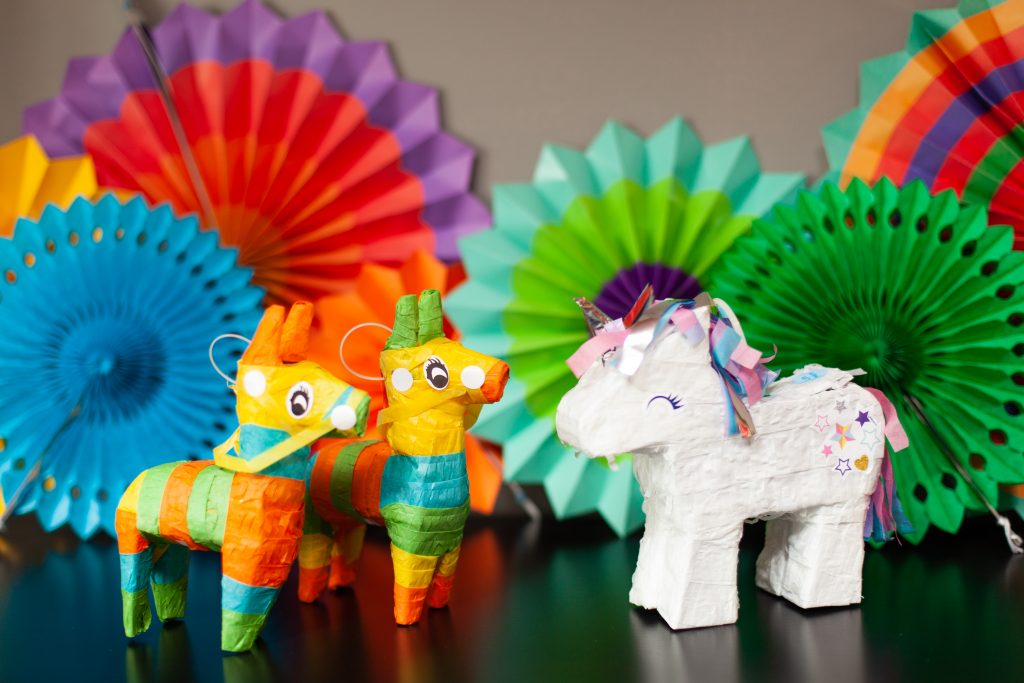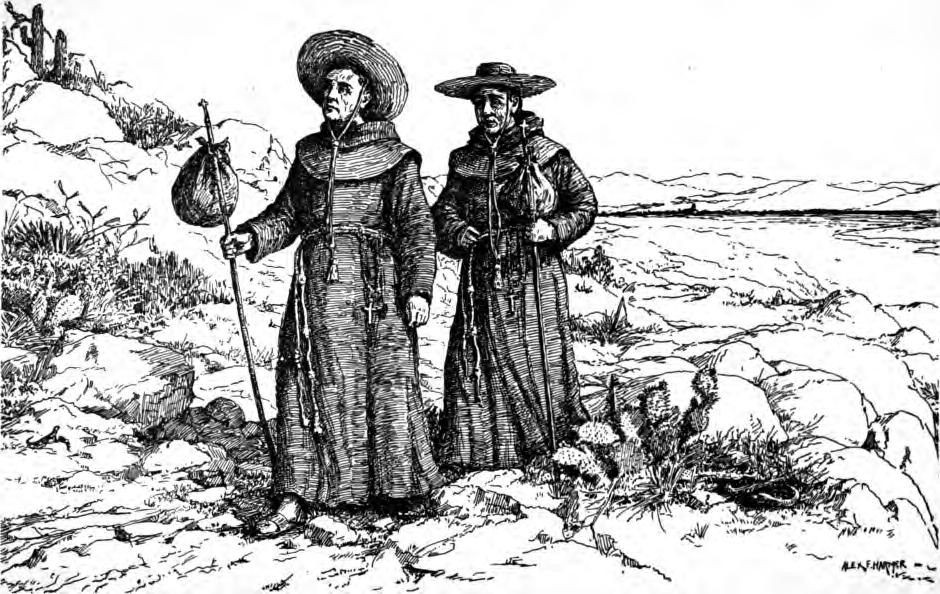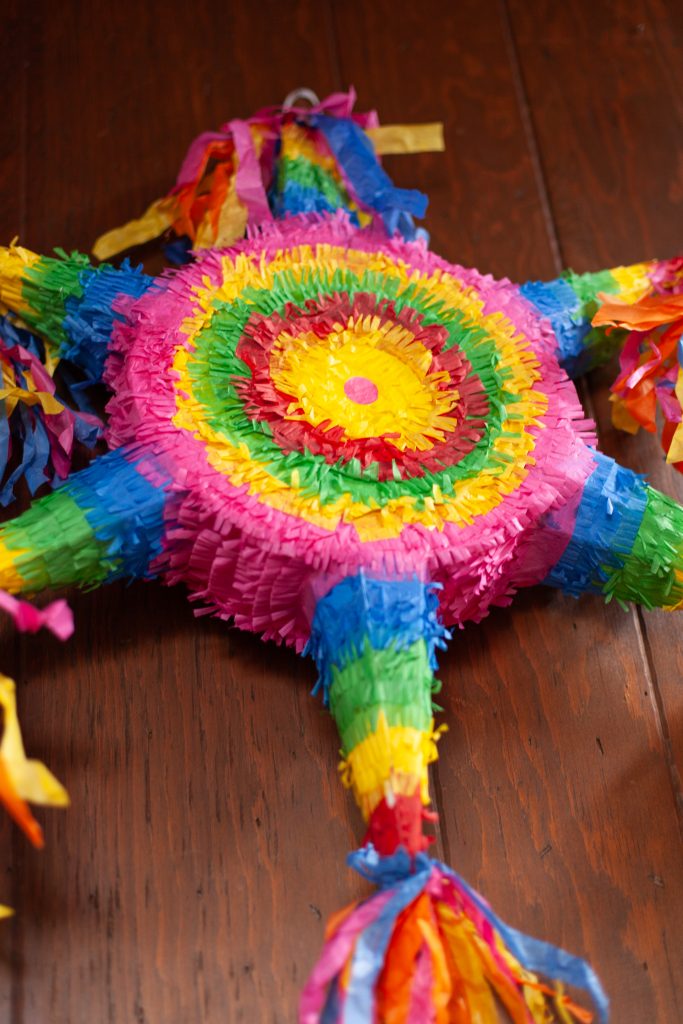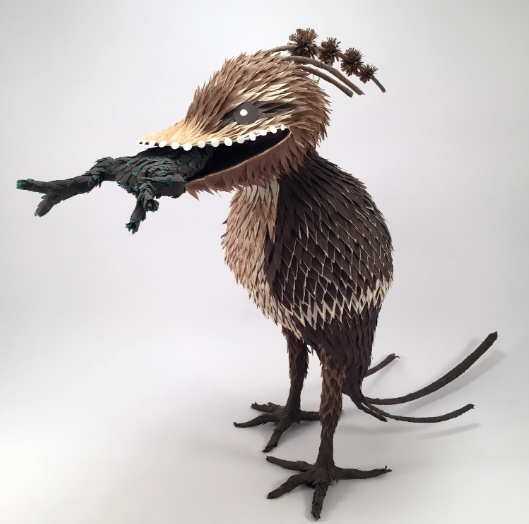Did you know that today, April 18th, is National Piñata Day?! Well, you do now, so Happy National Piñata Day!
It appears that the first mention of celebrating piñatas in holiday form was addressed by illustrator Amy Watkins. In March 2016, Watkins posted on her blog, Cozy Reverie, that she couldn’t believe this holiday didn’t exist already. With help from some friends, Watkins turned National Piñata Day from an idea into an actual celebration! My only question is: how is her face not on the $100 bill yet?!
Prefer to Listen?
Listen to our podcast episode Piñata Yadda Yadda: The History of the Piñata.
When you think of a piñata, you may conjure up images of blindfolded, stick-wielding people whacking a brightly-colored, papier-mâché figurine that is hanging from a rope. You might imagine the moment when the stick finally makes contact with the piñata and WHACK! The piñata bursts open with sweet treats or small toys. You may also envision Mexico, the birthplace of the piñata.
Well, get this: Mexico may not actually be the birthplace of the piñata. And you know the paper piñatas that we all know and love? Yeah, it turns out that those were originally (and some still are!) made of clay…ouch.
What’s a Piñata?

In case you’ve never played with one or just need a little refresher, a piñata is a container made of either papier-mâché, cloth, or clay that’s modeled into the shape of a person, place, or thing. The body of the piñata is then covered in a variety of brightly-colored tissue paper.
While some modern piñatas are still made with a clay center, like those in Acolman, Mexico, most commercially available piñatas in the United States are constructed out of cardboard or papier-mâché.
Once the piñata has been assembled, it’s then filled with candy, toys, fruits, or any other fun treat. Once it’s filled, it’s then hung up from the ceiling or the branch of a tree and then it’s hit repeatedly with a stick so that it bursts open, spilling its wonderful guts all over the ground. Today, piñatas are primarily used in celebrations, like birthdays or Las Posadas.
Where did the Piñata Originate?
While there are records of the piñata existing in various civilizations throughout it’s lifetime, the exact date of creation and country of origin remains unknown. This is largely due to the movement of nomadic groups and lack of written records throughout the millennia. Because of this movement, deciphering exactly who, when, and where these figures originated is almost impossible.
As it currently stands, though, scholars have narrowed down the possible points of origination to three civilizations: before or during the Yuan dynasty in China, the ancient Mayans, or the ancient Aztecs.
Marco? …Polo!
If the piñata originated from China, then we might have Venetian merchant and explorer, Marco Polo, to thank for bringing it to the Western world.

Venetian merchant and explorer Marco Polo via Wikimedia Commons.
While visiting China during the Yuan dynasty, Polo allegedly witnessed a group of people playing a peculiar game. They had created a variety of vibrant, small, paper-covered figures in the shapes of animals, like cows, chickens, and oxen. These figures were then hung from trees.
The group of people who participated in the game would blindfold one of the participants. This person would then go around trying to hit the paper-covered figures with a stick until they burst open. When they finally busted, a smattering of seeds spilled all over the ground, symbolizing growth in the New Year. The vessels were ceremoniously burned and the ashes, along with the seeds, were gathered for good luck.
To Venice, With Love
Apparently, Marco Polo really enjoyed these paper-covered figurines because it’s believed that he brought some back to Venice, Italy. The Venetians became quite fond of these as well and began to manufacture their own versions.
The Venetian versions were created from contemporary clay water pitchers, causing them to be called la pignatta, or “fragile pottery.” The pignatta became an integral part of Catholicism and they were reserved for use during the first Sunday of Lent, also known as “Piñata Sunday.”
From la Pignatta to la Piñata

As the custom spread to Spain, the Spaniards fashioned their pignatta a bit differently than the Italians. They translated the Italian “pignatta” into the Spanish “piñata” whose root word “piña” is Latin for “cluster of fruits or flowers” or “pinecone.” Therefore, Spanish piñatas were created with a distinct pinecone shape.
At first, the clay Spanish piñatas went undecorated. As the piñata gained religious significance, however, the decoration of these pots changed. Later versions were decorated by missionaries with brightly colored paper, ribbons and tassels with the sole intention of teaching the indigenous peoples in North America about Catholicism.
Journey to a New World

As Spanish missionaries traveled to North America in the 16th century, they brought not only disease and death, but their decorated piñatas, too. The piñatas, however, weren’t brought as an act of good faith. The missionaries brought them as a way to entice the indigenous peoples to convert to Catholicism.
What Spanish missionaries didn’t anticipate, however, was that two groups of indigenous peoples, the Mayans and the Aztecs, already had their own versions of the piñata!
The Mayans, who were huge fans of sport and physical activity, played a game where they would suspend a small clay pot from a rope. The person who was about to hit the pot had their eyes covered to make the game more intense.
The Aztecs also had a similar activity.

To honor the winter solstice as well as the birth month of Huitzilopochtli, the god of war, Aztec priests would place a small clay pot filled with feathers and stones on a pole within the temple. A person would enter the temple, grab a stick or club, and take their turn whacking the clay pot. Once it broke open, the vessel spilled its contents on the ground in front of the image of Huitzilopochtli as an offering.
When the Spanish missionaries learned that Huitzilopochtli’s birthday was in December, they used this to their advantage. The missionaries believed that transitioning the Aztecs from honoring Huitzilopochtli to honoring Jesus Christ would be easier than anticipated.
And they used the piñata to aid in this transition.
The Piñata: Symbol of Satan

According to records in Acolman, Mexico, it was in 1586 (nearly 300 years after Marco Polo allegedly witnessed the Chinese version) when Spanish missionaries began the migration of celebration during the month of December from honoring Huitzilopochtli to honoring Jesus Christ.
To aid in this effort, missionaries co-opted the way that Aztecs provided an offering to Huitzilopochtli, but with symbolism pertinent to teaching the lessons of Catholicism.
They still used a clay pot filled with goodies, a stick, and a blindfold, but the missionaries injected each item and action with very different meanings. Here are a few examples that they used:
- The addition of colorful papers, feathers, and ribbons was intended to symbolized the attractive mask that Satan wears to attract and seduce humanity.
- The traditional style of piñata, which has seven points, is modeled after the Star of Bethlehem, and each of these points stands for the 7 deadly sins. (The donkey piñata is meant to signify the donkey that Mary rode on in her journey to Jerusalem.)
- The piñata, itself, symbolizes hope and charity.
- The candies and fruits inside the piñata represent the temptations of wealth and earthly pleasures.
- The blindfolded person represents the “blind” faith that you must have in Jesus Christ.
- The person hitting the piñata was spun around 33 times to symbolize the lifetime of Jesus Christ. The spinning was also meant to represent the confusion and disorientation that occurs from a lack of faith.
- The stick represents the virtue that can overcome evil.
- When the piñata is broken, the goodies that pour out of it signify the divine gifts that are bestowed upon a person for keeping their faith.
Thankfully, the piñata has lost most of its allegorical connotations and can now primarily be enjoyed for entertainment!
The Next Big Change for the Piñata: The Invention of Tissue Paper
On December 8, 1857, American inventor Joseph Gayetty marketed a product that was completely innovative, yet totally mundane by today’s standards: toilet paper. Gayetty originally formulated each sheet of Manila hemp paper to contain aloe in an effort to treat hemorrhoids. Soon after it’s debut, however, plain sheets of toilet paper were available for purchase.
In 1863, Ebenezer and Ellen Butterick debuted a similar invention. They took Gayetty’s invention and formulated it into something totally different: tissue paper dress patterns.

Due to these two events, it can be suggested that piñata-makers, or piñateros, would have at least had the ability to cover piñatas with colored paper starting in the mid-1800s. Though, it is still unknown exactly when tissue paper was used for decorating the clay pot body of the piñata.
It appears that the clay body of the piñata evolved into cardboard or heavy stock paper sometime in the 1930s or 1940s in both Mexico and the United States. Today, the majority of piñatas are created with a cardboard, heavy card stock, or papier-mâché body. In Acolman, Mexico, though, you can still purchase a piñata with a traditional clay body.
The Art of the Piñata
While there are fewer and fewer piñateros, or piñata-makers, Mexican and Central American artists are keeping the art of the piñata alive in other ways.
Justin Favela
Mexican and Guatemalan artist, Justin Favela, uses cardboard and paper to create his art pieces. In an article from Colossal, the Las Vegas-born Favela states that he uses “…the piñata as a medium because I see it as the perfect symbol that stands for my identity and by using it, I am reclaiming the piñata and the culture it represents.”

In his work, Justin takes the fringed, papier-mâché aesthetic of a piñata and uses it to create exaggerated works that critique stereotypes of Mexican & Central American culture. His subjects range from a life-size lowrider as seen in Gypsy Rose Piñata to a donkey piñata that appears completely dejected and exhausted in Donkey Piñata.

Favela also creates immersive landscapes using the piñata as medium. For his piece Fridalandia, Favela created an expansive and immersive experience. Visitors walk through a re-creation of Frida Kahlo’s Casa Azul patio garden as it was portrayed in the 2002 film Frida and can then see a massive mural portraying a background similar to the paintings of José María Velasco. By combining a painting that would be considered a form of high art with the handicraft nature of a piñata, Favela critiques the perceptions and stereotypes of Mexico.
Roberto Benavidez & the Garden of Earthly Delights
Roberto Benavidez is another artist who has used the medium of the piñata to critique stereotypes and the imagined appearance of high-brow vs. low-brow art. While Benavidez creates piñatas of plants, animals, and other figures, he is most well-known for the series of piñatas he created that are based off of Hieronymus Bosch’s Garden of Earthly Delights.

Garden of Earthly Delights is part of the canon of an introduction to art history. Every student who has studied art history is familiar with this piece, if even just at the surface level. And once you see the horrific, surreal imagery of the Garden of Earthly Delights, it sticks with you for the rest of your life.
Benavidez introduces a new layer of complexity to Bosch’s terrifying painting by turning a few of the horrific creatures into piñatas. And not just any piñatas…these are life-size creatures from Hell. By associating these monsters, which were meant to be horrific, with the image of the piñata, which is typically an item associated with celebration, there is a great dichotomy here. Benavidez turns “high art” that is never intended to be destroyed into something “low brow” that is created just to be destroyed.
Celebrate National Piñata Day with my Perfect Piñata Party Kit!
Are you looking for the perfect party supplies to celebrate the best holiday ever?! I’ve got you covered! Here are a few of my favorite party supplies for National Piñata Day! I hope they provide as much fun to you as they have to us! 🙂
Piñatas
- I bought these immediately. They’re so small and cute! They look great on a buffet, bookshelf, or even in your office!
- Let’s be real…what kind of a party would it be without a taco piñata? This one is great, too, because it comes with a stick!
- This piñata may or may not be based off a well-known tequila brand *cough cough, Patron!* Like the aforementioned taco piñata, this one also comes with a stick!
- The piñata I used in my video isn’t sold anymore, but this one is very, very similar!
Decorations
- I LOVE these festive paper decorations! They brighten up the house in such a fun way!
- These are also really lovely to hang from the ceiling and remind you of the paper thin border separating our living world from the spirit world.
- I am high-key obsessed with these plates…omg!
Show Me How You Celebrate National Piñata Day!
How will you celebrate National Piñata Day? Have you ever created your own piñata or do you know a piñatero who still makes piñatas by hand? Let me know in the comments below! 🙂
And be sure to tag me on Instagram @amara_andrew to show me how you celebrate National Piñata Day! 🙂


Leave a Reply